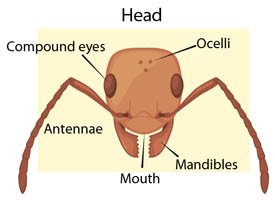Ant eyes, ultraviolet vision, and death spirals
The question for this post is this:
How do ants see things?
“With their eyes, of course,” would be an obvious answer to that question. But do ants have eyes? And if they do, are those eyes anything like ours? Does the world appear to ants as it does to us?
Let’s begin.
Do they have eyes?
Yes and no. This is probably the right time to remember again that the number of ant species on earth is very large. When we look at the anatomy of ants or at any physiological process inside the ant body, great diversity can be observed among the species that we already know about. And we have to remember that vast numbers are yet to be studied in detail.
Some ants do not have eyes.
Some ants are found to be completely blind or they are found to have poorly developed eyes. For example, a group of about 200 ant species collectively termed as army ants are blind or near-blind. This leads to very serious problems if they lose the pheromone trail by accident. One solution used by these visionless ants is called tandem running in which one ant that acts as the leader will walk ahead of another ant that acts as the follower. The follower will frequently touch the leader with its antenna to make sure they are together.
You can guess how this could be a problem.
The whole theory of tandem running assumes that the leader knows where it is going. Imagine a scenario in which the leader is also lost and follows another ant which is also lost giving rise to an extreme case of the blind leading the blind. In some cases, all of the ants in a group end up losing the pheromone trail and everybody starts following everybody else in a big confused spiral until they all die of exhaustion. This tragic phenomenon is called an ant mill.
If you like watching sad ant events, you can watch a video of an ant mill here.
But not all ants are blind.
Ants that are visually sophisticated have two systems for visual perception. First, they have compound eyes that are used for projecting an image of the world like our own eyes do. But compound eyes cannot really create a high resolution image that our visual system does. This is mostly because the ant eyes have fewer receptors, and they have a number of fixed lenses unlike our own eye lens which automatically adjusts for focusing at different depths. So the ants see a grainy low resolution image of the world which is acceptable for rudimentary functions such as detecting movements and shapes.

Ants have compound eyes for image formation, and ocelli for detecting light level and polarization
Ant head image created by DmdM, extracted from Wikimedia commons
In addition to the compound eyes, ants also have three small “ocelli” or “simple eyes” which they use for the detection of light levels and to measure polarization of light. We have seen that this is important because ants use the information about light levels and polarization to navigate using the position of the sun.
Do ants see in color?
Apparently, yes. And it appears that some ants can see colors that we do not see.
This requires a little discussion of how color detection works.
The color of an object is determined by the wavelength of light that gets reflected by the object and in turn gets detected by the receptor cells in our eyes. The human eye has three different receptors for red, green, and blue, and all the other colors are created by the combined effort of these receptors. This can be illustrated in a rainbow where the bands gradually change from red to green and then to blue and its variations.

There are light waves beyond the violet and the red bands, but our eyes are not equipped to detect light at those wavelengths.
Image from pixabay
Now light has wavelengths longer than the wavelength of red light, and it also has wavelengths shorter than the wavelength of violet light. Our eyes simply do not have the instruments to detect the light beyond the borders of the rainbow, which are called the infrared range (beyond red) and the ultraviolet range (beyond violet).
In case of ants with a developed vision system, like the Australian bull ants, the eyes have evolved to detect blue, green, and ultraviolet light. (A dog, for comparison, has detectors only for yellow and blue light). This extraordinary ability of the tiny ant eyes has even been identified as a possible model for robotic vision systems which need to be compact and informative at the same time.
The conclusion
The conclusion is that ants can be blind, or they can have a system of compound eyes (for detecting motion and shapes) and ocelli (for measuring light level and polarization). They can see in color too, and they apparently see colors in the ultraviolet range that we never see. Also, blind ants can sometimes follow one another in a circle until they die.
I feel like this post turned out to be a little monotonous with one piece of information after another, but then we saw the sad but interesting phenomenon of the ant mill, and also discovered that some ants can see ultraviolet light. Thank you for reading, and please let me know your thoughts in the comments.
Links to references and image sources are provided in the text.
When I watched that film as a child, I certainly didn't know that much about ant vision...
You're giving us great posts! Keep it up!
Thanks for reading and for the encouragement. :) This reminds me that I should probably do some posts about how ants are depicted in popular culture.
Oh! I'd love to see that! There are lots of stories and animation films with ants, I believe you'll have plenty of things to write :)
ohhh
I have never thought of Ants from the perspective of their vision...
Interesting article @zycr22,
I hope ants can hear sounds too.
I am glad you found it interesting. And I recently wrote a post about how ants use sound for communication. I don't know if we can call it "hearing" but they do seem to sense the vibration and convey information using sound. You can click here in case you want to read that post.
interesting informative post.
Thank you for reading.
welcome.
@reported has voted on behalf of @minnowpond. If you would like to recieve upvotes from minnowponds team on all your posts, simply FOLLOW @minnowpond.
Your post was resteem by Whale ResteemService @booster007
Keep it up!
All the best!
First Follow for 3 hours | Send a transaction with post URL | Your post gets resteemed | A post can only be resteemed once!
the best post
nice information
Thank you for reading.
Probably, Antennae also has a role in positioning and by ultrasound like the bat I think
ohh nice concept
I have yet to come across ultrasound perception, but they do seem to use the antenna for detecting chemical signals and for "feeling." I have addressed some of these issues in my previous posts. Thank you for reading!
Hi @Zycr22, you are obviously fascinated by those tiny animals - I followed you. I am (or was) an ant fan by myself, tons of unbelievable things about them, you might want to check out this one: https://steemit.com/science/@stayoutoftherz/brain-manipulative-microbes-new-explanation-for-some-kinds-of-delusion
@cmtzco has voted on behalf of @minnowpond. If you would like to recieve upvotes from minnowponds team on all your posts, simply FOLLOW @minnowpond.
To receive an upvote send 0.25 SBD to @minnowpond with your posts url as the memo
To receive an reSteem send 0.75 SBD to @minnowpond with your posts url as the memo
To receive an upvote and a reSteem send 1.00SBD to @minnowpond with your posts url as the memo